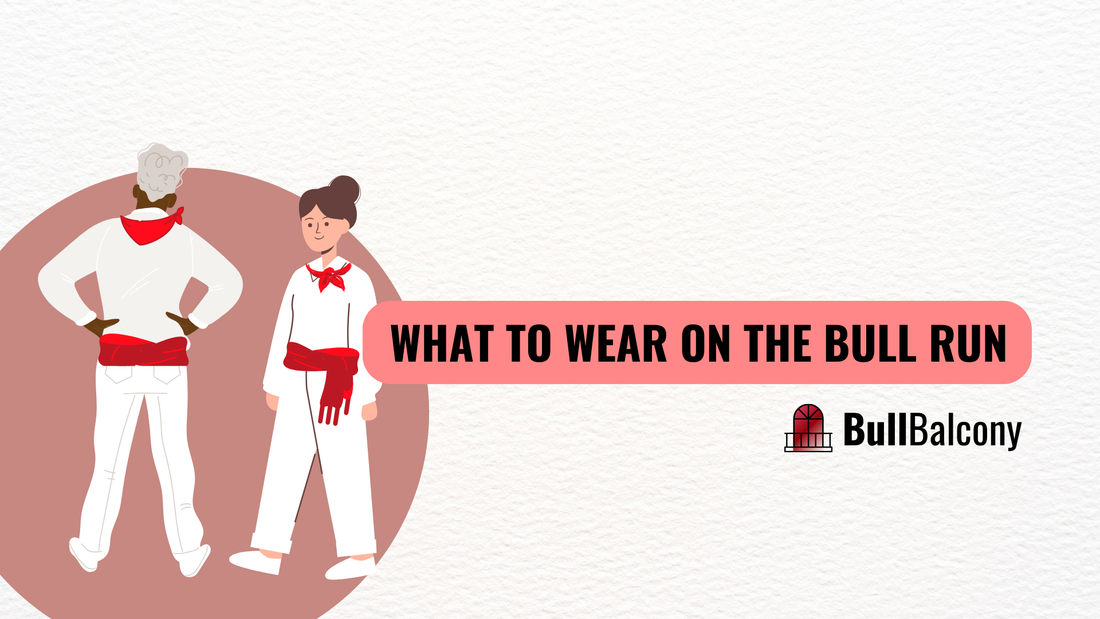
What to Wear While Running with the Bulls
Share
Wondering what to wear during the San Fermín (Running of the Bulls) festival?
The traditional outfit is simple: all-white long pants, an all-white shirt, a red sash tied around your waist, and a red handkerchief tied as a scarf around your neck.
Don't worry: you can get everything you'll need to look the part when you arrive in Pamplona. All the necessities are sold by vendors on every street in Pamplona's Old Town (where the festival takes place), and complete outfit packs including wide-leg white pants, a white shirt, a scarf, and a sash go for around $35-50 USD. If you're looking for higher quality clothes, we recommend bringing white clothes from home. Typically, people wear wide-leg, loose-fitting linen blend or cotton pants. Any comfortable white T-shirt or long-sleeve shirt is fine!
The red pañuelo (the handkerchief-scarf) and red faja (the waist sash) can easily be purchased on any street in the Old Quarter of Pamplona for around $5 USD. That being said, if you would like to order customized scarves and sashes engraved with your name or company name, you should order these items in advance. You can order these items in advance for $35 each from BullBalcony - just send us a quick email with your request.
If you actually plan on running with the bulls, you'll need to follow some extra rules. Check out our graphic for more details, and read on for more tips!

What shoes should I wear?
You'll need to wear comfortable, closed-toe shoes on the bull run. Ideally, you'll want to bring a great pair of running shoes that you can easily sprint in. Don't forget to break them in before you arrive in Pamplona!
What white clothes should I buy?
Any plain white shirt is fine, but your pants should be comfortable pants, joggers, or sweatpants with an elastic band. You'll need clothes that you can easily run in, so make sure you buy comfortable clothes that fit well. Please note that you must wear pants - shorts, skirts, and dresses aren't allowed on the bull run.
Ideally, your pants should also have a zippered pocket where you can bring an ID, some cash, and any other belongings you may wish to bring with you when you run with the bulls. Alternatively, plan to wear a thin money belt inside your pants to keep your belongings safe on the run.
Are white jeans okay?
It's not recommended to wear jeans on the bull run, as denim can severely limit your mobility, thereby posing a danger to yourself and others on the bull run. The best choice is to wear linen, nylon, or cotton pants with an elastic band so that your pants stay secure and comfortable while you run.
What about the rolled newspapers?
You may have seen pictures or videos of people running with a rolled newspaper in one hand. Running with a rolled newspaper has been a popular tradition among bull runners for decades, and today this tradition is practiced for several different purposes. For example, rolled newspapers are often used to help runners judge the distance between themselves and the bulls. They are also used to distract the bull in dangerous situations by giving runners something to throw (which will divert the bulls attention to the newspaper), and they are sometimes used to give runners something to grip to channel stress and fear during the run (much like a rubber stress ball). If you plan to bring one, you can buy the daily newspaper in Pamplona on the day before your bull run, or you can bring a newspaper from your hometown to have a piece of home with you on the run!
What is not allowed on the bull run?
There are several things that you cannot bring or wear while running with the bulls. For example, flip-flops, sandals, shorts, dresses, and skirts are all not allowed on the bull run. Please do not come wearing any of these prohibited items: You will be kicked off the bull run course for breaking the rules. You also cannot bring a camera, a water bottle, a backpack, or a purse with you on the bull run. These items can slow you down and their straps can get caught, making you a risk to yourself and to others.
How do I put on the scarf?
The pañuelo is a small red square with an emblem of the fiesta (typically a picture of San Fermín, a bull, or the flag of Navarra) engraved into one corner. To put your pañuelo on, simply fold the square in half diagonally once, so that the square is now a triangle and the emblem of the fiesta is in the middle of the three new corners. Then, tie the end corners around your neck in a basic knot, so that the emblem of the fiesta is showing on your back. It shouldn't be tied tight - you should be able to breathe comfortably with it on.
Why do people wear red and white outfits in Pamplona?
There is a common myth that the red in the outfit symbolizes the blood of the 3rd-century Christian martyr, San Fermín de Amiens, and the white symbolizes his purity or sainthood. It's a nice story, but it's simply not true. In fact, these red-and-white outfits have only been around since around the 1900s - long, long after the festival had transformed into something almost completely secular. In other words, the traditional outfits have nothing to do with the largely obscure 3rd century saint.
In reality, the white outfits evolved from the traditional white "blusas" or knee-length smocks that were once used by members of the working-class to protect their clothes during potentially messy tasks. In the 19th and early-20th centuries, most people wore full suits during the traditional bull run. However, the less-wealthy members of society couldn't risk ruining their best outfits, so they covered up with a cheap white smock before the run. By the 1920s, these white outfits had become a symbol of the (often messy) fiesta as a whole, and the tradition gradually spread beyond the working-class. Clothing styles changed with the times, but, in reference to the traditional smocks, cheap white shirts and pants became the most popular choice for festival-wear.
By the start of the Spanish Civil War in the late 1930s, all-white outfits became even more popular, as they symbolized an allegiance with the working-class, which in turn symbolized anti-fascist, anti-dictatorship, and anti-nationalist sentiment. A few decades later, this tradition had become almost universal during the festival, so much so that wearing clothes of any other color would suggest that you are not celebrating the festival.

The use of red scarves (called pañuelos) and sashes (called fajas) at the San Fermín festival is also a relatively new tradition. Since at least the 19th century, scarves and sashes of all colors have been worn across northern Spain and southern France as identity markers. Performing what is essentially the same function as team jerseys or bandanas, the colors, symbols, and patterns of pañuelos and fajas tell people what village, city, or region you are from within the Basque country, what social group you belong to, or what ideology you support. Still today, pañuelos and fajas are worn in even the most remote regions of the Basque country, where the saint San Fermín de Amiens is almost completely unknown and certainly not celebrated; in other words, wearing a scarf and a sash has nothing to do with the saint or his martyrdom.
So why do people now wear red scarves and sashes in Pamplona? Posters and photos of the festival from the early 1900s give evidence that scarves and sashes of all colors were once worn in Pamplona during the San Fermín festival. Green, blue, and yellow scarves and sashes were just as popular as red scarves and sashes until around 1930. Around this time, members of "La Veleta" peña, a local social group, chose to wear red pañuelos and fajas to demonstrate their group membership.
By wearing red to demonstrate membership in La Veleta, participants also symbolized their support of La Veleta's ideology: one that celebrated Basque culture, advocated for socialism and secularism in government, and strongly opposed fascism and Francisco Franco's dictatorship. As political tensions bubbled on the brink of the Spanish Civil War, red pañuelos and fajas became an increasingly popular way of symbolizing one's resistance against the fascist regime, even for people who weren't members of the La Veleta social group. The fashion choice gradually became so popular that it was adopted as the default choice for people celebrating the festival, thus creating a new tradition at the festival of San Fermín.
Reach out!
If you have any questions about what to wear on the bull run or how to prepare, feel free to contact us. We're happy to help!
